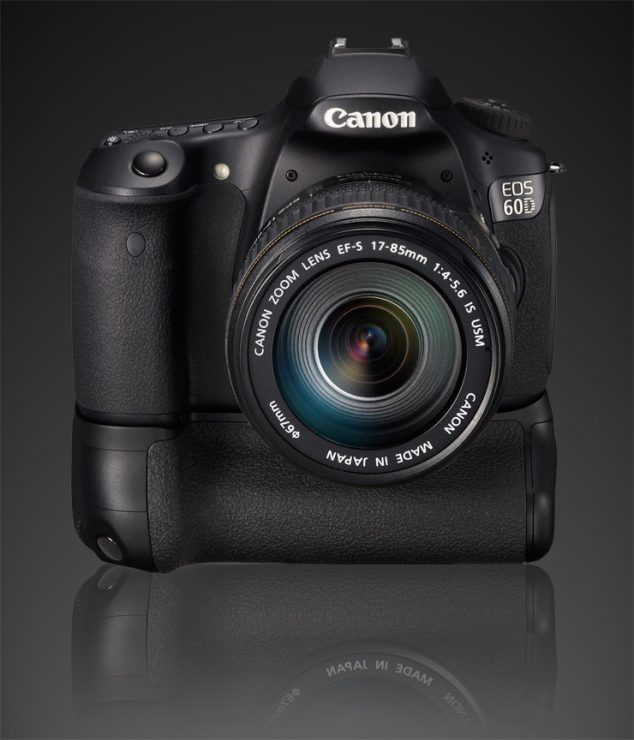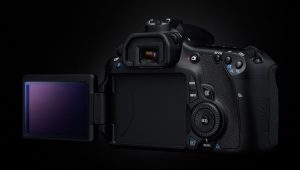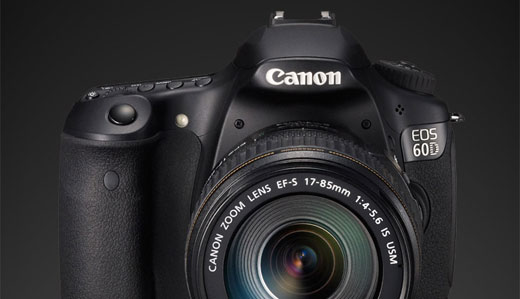The Great Compromise : Canon EOS 60D

Since the arrival of the Canon EOS 7D and subsequent release of the T2i / 550D there has been a gap in the Canon lineup. Buying the 50D no longer seemed practical to many advanced amateurs, since it was so outclassed by the features of the T2i, but the price of the 7D put it just beyond the range of what many were willing to spend (and the weight and size beyond what they were willing to tote around). Yet, the advanced amateur still yearned for more features and ease of control, and frankly, more status than is offered by the entry level “Rebel” line.
[Update: The release of the Rebel T3i has added an interesting new dimension to this discussion. See how the T3i and 60D differ, here]
The Canon EOS 60D, announced about recently, is clearly intended to fill this gap. Available since September, its price of $999 falls nicely between the Rebel T2i ($799) and the 7D ($1535). Its features, also, are largely intermediate between the two cameras that were already very similar. The controls are similar, but not identical, to the 7D, while the construction is much more in line with the T2i than the 7D (or the 50D, for that matter).
Lets take a quick look at the differences, side-by-side:
Canon 7D Canon 60D Canon Rebel T2i / 550D
Amazon Price $1599 $999 $715
B&H Price
$1599 $999 (rebates available) $719
Body Material Magnesium Alloy Polycarbonate and Stainless Steel Polycarbonate, Fiberglass Resin and Stainless Steel
LCD Size / Resolution 3.0"
920,000 pixels3.0"
1,040,000 pixels3.0"
1,040,000 pixels
LCD Articulated? No Yes No
Sensor Size 14.9 x 22.3mm (APS-C) 14.9 x 22.3mm (APS-C) 14.9 x 22.3mm (APS-C)
Crop Factor 1.6x 1.6x 1.6x
Sensor Resolution 18 Megapixels 18 Megapixels 18 Megapixels
ISO Range 100-6400
+12800100-6400
+12800100-6400
+12800
Total AF Focus Points 19 9 9
Cross-Type AF Sensors 19 (dual diagonal) 9 1
AF Light Level Range -.05 to +18 EV -.05 to +18 EV -.05 to +18 EV
Metering System 63 Zone Point Linked Evaluative
9.4% Center Weighted
2.3% Spot 63 Zone Point Linked Evaluative
6.5% Center Weighted
2.8% Spot 63 Zone Point Linked Evaluative
9% Center Weighted
4% Spot
Exposure Compensation 1/2 or 1/3 stops via thumb dial 1/2 or 1/3 stops via thumb dial 1/2 or 1/3 stops
Auto-Bracketing
/ HDR Options
Max Frame Rate : RAW (14-bit) 8 fps 5.3 fps 3.7
Max Frame Rate : RAW (12-bit) n/a n/a n/a
Max Frame Rate : JPG 8 fps 5.3 fps 3.7
Max Burst Duration RAW (at highest frame rate) 15 16 6
Max Burst Duration JPG (at highest frame rate) 94 58 34
Shutter Speed Range 1/8000th - 30 sec.
+bulb1/8000th - 30 sec.
+bulb1/4000th - 30 sec.
+bulb
Maximum Flash Sync Shutter Speed (standard flash) 1/250th sec. 1/250th sec. 1/200th sec.
HD Video Resolutions 1080p, 720p 1080p, 720p 1080p, 720p
Available HD Video Frame Rates PAL and NTSC
24/25, 30 at 1080p
24/25, 30, 60 at 720pPAL and NTSC
24/25, 30 at 1080p
24/25, 30, 60 at 720pPAL and NTSC
24/25, 30 at 1080p
24/25, 30, 60 at 720p
Firmware Sidecar Available Under Development No No
Media Type Compact Flash SD / SDHC / SDXC SD / SDHC / SDXC
Weight 820g (body only) 675g (body only) 530g (with battery and SD card)
Viewfinder Coverage 100% Frame,
1.0x magnification96% Frame,
.95x magnification95%
0.87x magnification
Built-In Wireless Strobe Control Yes Yes No

Probably the most important change between the 60D and the previous models in its line is that it does NOT have a metal body. Instead, Canon opted for a lighter, less expensive polycarbonate body which, although lighter than the magnesium 7D, still feels quite sturdy.
And perhaps just as significant, Canon has designed the 60D with a fully articulated, 3″ LCD screen for use in “Live” viewing mode and for video… the first ever on an SLR. Since I never use “Live” mode, and rarely use video, it’s hard for me to get excited about this feature, but perhaps for some photographers out there, it’s just what they’ve been waiting for.
The Deciding Factors
All three cameras share the same basic CMOS sensor, providing very similar resolution and high-ISO performance. All three cameras share the same video capabilities. So which should you get?
Buy the Canon 7D ($1535) if :
- You are a professional or use your camera daily. It is the most robust of the three, with a magnesium alloy body that will stand up to the wear and tear of daily use. This is especially important if you’re a journalist and your camera equipment suffers undue abuse.
- If you are primarily an action or sports photographer. The dual digic-4 processors of the 7D make it the fastest, and its 19 cross-type point focusing system is the most reliable in difficult situations.
- Because the 7D has two Digic-4 processors, it is likely to be able to handle high definition video files better than single processor models, though I’d be surprised if there’ll be much of a practical difference.
Buy the Canon 60D ($999) if:
- You want the 7D but can’t afford it. The differences are minimal, and a good photographer can easily work around them.
- You shoot a lot of video and the articulated LCD would be helpful to you.
- If you’re upgrading from the Rebel line and would like to keep using your SD cards.
- You shoot a lot of action. The 9 cross-type focusing points are a major improvement over the Rebel T2i (9 point, but only one cross-type) and even the 5D Mark II, (9 point, one cross-type). It does have the same AF system as the 40D and 50D.
- You’re looking for a lighter alternative to the 7D.
- You want to wirelessly control Canon speedlites using a built-in pre-flash system.
Buy the Canon Rebel T2i / 550D ($799) if:
- You’re on a tight budget but still want an awesome 18 megapixel sensor, full features, and 1080p video.
- If you’re looking for a lightweight camera for travel and will be able to treat it with a bit of care, or a backup for your usual camera.
- If you primarily shoot portraits or products rather than action, or shoot landscapes/art.
- If you aren’t interested in shooting with wireless flash, would prefer to use radio triggers, or wouldn’t mind adding the wireless control unit (Canon ST-E2 transmitter).







